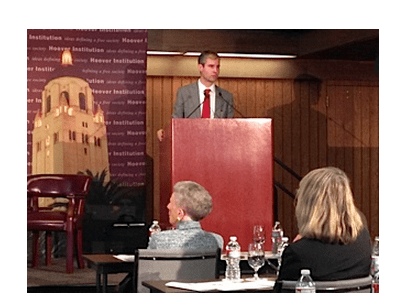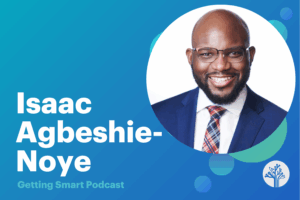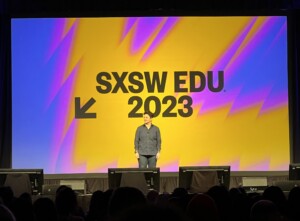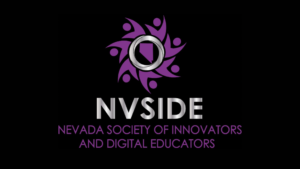Hoover Conference Explores Blended Learning

Michael Horn, Christensen Institute, kicked off a small wonkish blended learning conference at Hoover Institution Thursday by providing supporting evidence for his Disrupting Class prediction that 50% of high school classes would be online or blended before the end of the decade–a prediction that seemed crazy five years ago but will achieved before the stated target.
Horn outlined the four blended models (see Christensen’s Blended Learning Universe for school profiles in each category):
- Rotation models: lab rotation (e.g., Rocketship), class rotation (e.g., KIPP Empower), individual rotation model: (e.g., Carpe Diem) and flipped classroom.
- Flex: dropout recovery models like AdvancePath, Silicon Valley Flex, and Nexus from Connections Learning.
- A la carte: students choosing individual online courses (e.g., Louisiana Course Choice, Florida Virtual School).
- Enriched virtual model: an online school with on-site check in.
Differentiating blended from competency-based learning, Horn highlighted the working definition of high quality competency-based education from CompetencyWorks (supported by iNACOL):
- Students advance upon mastery.
- Competencies include explicit, measurable, transferable learning objectives that empower students.
- Assessment is meaningful and a positive learning experience for students.
- Students receive timely, differentiated support based on their individual learning needs.
- Learning outcomes emphasize competencies that include application and creation of knowledge, along with the development of important skills and dispositions.
Horn said, “The real opportunity is combining blended and competency-based learning.” He outlined for
- Tailoring learning for every student;
- Enable student voice and choice in what, how, where they learn;
- Provide flexibility and support to ensure mastery of high standards; and
- Personalization encompasses notions of differentiation and individualization.
How do blended classrooms work? A panel described blended classrooms. Jeff Baier, Los Altos School District, described blended math in grades 5-8 using Khan Academy. Suney Park, Eastside College Prep, is a sixth grade teacher that also uses Khan Academy for half of her math curriculum. Esther Wojcicki, Palo Alto High School, described (what I’m pretty sure is) the world’s best journalism program. Cindy Ambrose, Horry County Schools, described the blended journey of a 40,000 South Carolina district.
Esther said it’s critical that “the student own the learning and that the teacher is no longer in front.” Her students publish 9 world class publications that suggest the process is working.
Suney said blended learning is just an extension of good teaching, “Every teacher wants to use different modalities to meet the needs of every kid–blended learning is a path to differentiate and meet every student where they are.” She admitted that it was a difficult transition, “I didn’t give my kids enough credit for what they can learn from each other and on their own–I had to change my own definition of who I am.” Like Esther, Suney said, “I love seeing how excited kids are because they are in control.”
The panel concluded that blended learning has to be a bottom up, organic adoption by teachers–a reflection of the schools and districts they represented. The panel missed the “extended reach” strategies outlined by Opportunity Culture and in the SmartSeries paper, Improving Conditions and Careers.
Supply & demand. Secretary Rice moderated a panel on supply and demand for blended learning and the broadband and data infrastructure required.
Aneesh Chopra, Advisory Board (and former US CTO) said he was excited that blended learning would 1) allow expanded access to quality job skills training, 2) improve opportunities to personalize core instruction in K-12, and 3) meet the productivity imperative that Arne Duncan introduced (see Duncan’s Most Important Speech).
Julia Stiglitz, Coursera, said two emerging challenges are discovering content and thriving in an online environment. She noted that current MOOC learners are about 80% degree holders–about 40% in emerging market (but, interestingly, about 70% for teacher PD courses probably owing to US certification requirements). To boost worldwide completion rates, Coursera has opened learning hubs in 37 countries. For many, “a purely online experience hard to get through,” said Stiglitz.
Anthony Kim, Education Elements, said “blended learning allows us to take concepts and help students learn in different modalities” and in many cases “move students up to higher levels on Bloom’s taxonomy.” Kim said that when it comes to blended learning there are four types of EdLeaders: celebrity status reformer (e.g., Mark Edwards), under the radar movers and shakers, those that have stumbled and are fearful, and others (happy with the status quo). Chopra said the federal i3 grants are a way this administration surfaced and rewarded some of the “under the radar” leaders.
“When you get a taste of it, it’s so rational,” said Diane Tavenner, Summit Public Schools, of her experience as a parent of a student in a blended learning environment (at one of her blended schools). She thinks we’ll push through the current trend to course choice (i.e., taking individual online courses) to unbundled access to learning objects that can be incorporated into playlists in competency-based progression.
Asked if Summit’s playlist and project approach is unmoored from a rational scope and sequence, Tavenner pointed to their comprehensive assessment plan (which is the best outcome map I’ve seen).
Brian Greenberg, Silicon Schools, said, “When teachers and parents see great results from math products like ST Math and there’s no going back, “It’s like being in an arcade with unlimited quarters.” Kids are willing to try new things and learn from their mistakes.
Summit Public Schools does two things really well, according to Greenberg: 1) change management as a organization, and 2) exceptional dedication to continuous improvement and lean startup methodology. They not only use achievement data, they hold focus groups with students and ask them what’s working and what could be better. Greenberg recommended that administrators “spend time with their butt in a seat watching classroom interventions and developing hypotheses about how to make them better.”
Policy. To Rick Hanusheck’s question about what policy will make the biggest difference, Eleanor Laurans, Parthenon Group, and I suggested that building a plan is even more important than changing a policy right now. As outlined in the Blended Learning Implementation Guide, building a three year plan for the transition to digital learning is the most important thing a state or district leader could do.
The plan should start with updated goals for important student outcomes, should include a vision of personalized learning, and should incorporate a timeline for improving student access to technology and developing blended learning environments.
Because this plan renders virtually the whole education code obsolete, states should build a plan to rewrite their education policies using the blueprint 10 Elements of High Quality Digital Learning from Digital Learning Now!
Mike Kirst, a professor at Stanford and chair of the California State Board of Education, was enthusiastic about better tests from Smarter Balanced but a little nervous about field testing in all California schools this spring. He agreed that there were policies that needed to change but that there was enough room to run great blended schools like Rocketship and Summit.
Paul Peterson, publisher of Education Next, expressed more urgency, “We need a Race to the Top to see how fast states can get rid of their education code.”
Now what? Paul Hill, founder of the Center of Reinventing Education, said that for blended learning to have the desired impact it will require more new charters school. He enumerated the existing and constructed barriers to scale–including well intentioned efforts to improve teaching that result in standardization of the human resource pool, “Which is the last thing you want during an innovative phase” according to Hill.
Not surprisingly, Terry Moe, another member of the Koret Task Force (which was retired at a dinner gala on Thursday) agreed that the full benefit of digital learning will require thousands of new schools. I underscored the importance of new school development like the Bay Area work supported by Silicon Schools and nationally by Next Generation Learning Challenges.
One of the most interesting observations came from Brian Greenberg who said, “My son is forever different because of 9 months on a piece of software and there is no going back.” Both Brian and his son have new expectations about learning–and there are more than 100 million students and parent just like them.








0 Comments
Leave a Comment
Your email address will not be published. All fields are required.